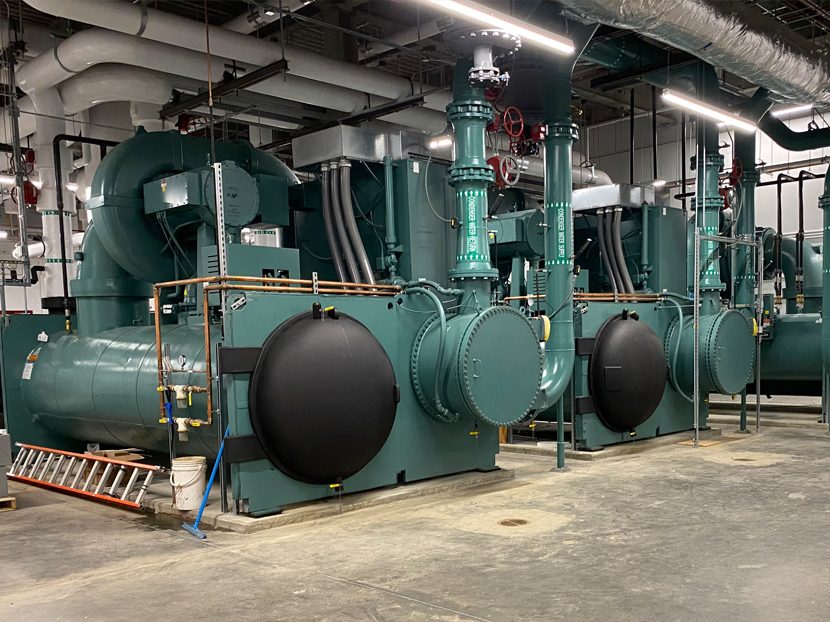Water Flow Matters More Than You Think
With today’s chillers and boilers featuring their own VFDs, equipment can be underflowed and overflowed and still function optimally.

Most people sitting at work are not thinking about the innerworkings of their building’s water supply or how its climate is controlled. Outside of a thermostat and the sinks in the kitchen, it just happens.
However, for those of us who live and breathe chillers, closed-loop systems, refrigeration, thermal transfer devices, liquid vaporization, vapor compression and more, we can’t get enough of it (on most days). And that’s a good thing as Americans spend about 90 percent of their time indoors.
Our facility management customers can’t afford equipment downtime or inefficient spaces – and no office worker wants an uncomfortable space. So, let’s talk chillers, moving the water that heats and cools our buildings, and the things we can do to ensure our systems are flowing as best as possible.
Two types of chillers
There are two types of chillers: water-cooled and air-cooled. They work similarly throughout most of the process until the refrigerant reaches the condenser.
We all know chiller machines are complex and require a lot of maintenance to keep them in good working order. Corrosion, restrictions, reduced capacity, diminished efficiency – these are all issues that can happen if proper steps are not taken. If open cooling towers are not cleaned, for example, or if proper water treatment is not maintained, sediment or particulates can accumulate, causing restricted pipes and poor heat transfer within the system. Additionally, an air-cooled chiller’s condenser can be blocked by debris or become caked in dirt, which also lowers efficiency.
So, by all means, keep an eye on that maintenance.
VFDs
Now for flow rates. Before the advent of variable-frequency drives, it was standard to pump water at a constant volume throughout a building. Different piping configurations would allow hydraulic bypasses as valves would close down. These days, flow rates can be adjusted and buildings can be converted from a primary-secondary system to variable primary flow so that all flow rates through the equipment are varied.
With today’s chillers and boilers featuring their own VFDs, equipment can be underflowed and overflowed and still function optimally. Variable primary flow chilled water pumping features are ideal for new facilities with large pumping loads as they have one hydronic loop directly connecting the plant and the building, as well as buildings that are operational 24-7, such as hospitals and manufacturing plants.
If one of your customers is exploring a retrofit to get a building’s water moving optimally – assuming the pumps are in good condition – chillers are a good place to start. Considered backwards compatible, most chillers can work with the old primary-secondary and variable primary systems. Move next to air handler(s) and valving, with a controls integration, if possible.
For this type of work, mechanical contractors will find a variety of design challenges exist. For instance, special attention must be paid to three-way valves used in the old design, which now don’t work well at the air handlers. There’s also the decouplers. While a decoupler was hydraulically decoupling the primary and secondary loops before, those decouplers now are closed off so the water is moved directly through the chillers and back out to the air handlers.
If you miss issues such as these or don’t complete a conversion project in its entirety, the energy savings from the intended retrofit will be minimal.
Here are some additional tips to optimize the water moving throughout a building:
• Focus on the chilled waterside and a variable primary system, staying above the minimum flow rates to avoid causing damage to the chillers. While slowing the water down will gain a few extra kW out of the pump, the chiller will suffer for it.
• The same holds true on the condenser side. If the water is slowed down too much there, it artificially puts a load on the chiller so the energy trying to be saved on that pump is transferred into the chiller, which doesn't perform correctly in some cases and can actually trip safeties.
• Avoid arbitrarily putting pumps together for the movement of water. Follow the minimum and maximum flow rates for your equipment. And consult with engineers who know equipment limitations to avert freeze-ups on the evaporator, etc.
• The amount of water and how quickly it’s changed, along with changing flow rate too fast, can also cause issues by overshooting set points with the chiller. Abnormal cycles on the chiller can result in or, even worse, cause a compressor surge.
• Consider competent engineering to examine overall usage, including present and future plans.
Flow rates are critical to chillers. There is a balance between water amounts and how quickly they’re changed, and how quickly flow rates are changed. It’s a dance best performed by working closely with operators, controls, customers and design engineers.
Steve Campbell, chiller team leader, Harris, has been in the industry for 33 years. Starting in construction and moving into service, Campbell has full-circle HVAC/R industry experience – from project start to completion and maintenance/repair.




